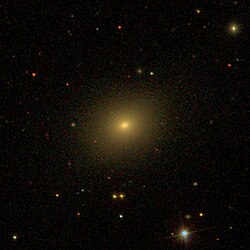NGC 7501
| Galaxie NGC 7501 | |
|---|---|
 | |
| SDSS-Aufnahme | |
| AladinLite | |
| Sternbild | Fische |
| Position Äquinoktium: J2000.0, Epoche: J2000.0 | |
| Rektaszension | 23h 10m 30,4s [1] |
| Deklination | +07° 35′ 22″ [1] |
| Erscheinungsbild | |
| Morphologischer Typ | E1[1] |
| Helligkeit (visuell) | 13,6 mag[2] |
| Helligkeit (B-Band) | 14,6 mag[2] |
| Winkelausdehnung | 0,5' × 0,5'[2] |
| Flächenhelligkeit | 12,2 mag/arcmin²[2] |
| Physikalische Daten | |
| Rotverschiebung | 0,042663 ± 0,000103[1] |
| Radialgeschwindigkeit | (12.790 ± 31) km/s[1] |
| Hubbledistanz H0 = 73 km/(s • Mpc) | (578 ± 40) · 106 Lj (177,3 ± 12,4) Mpc [1] |
| Durchmesser | 85.000 Lj[3] |
| Geschichte | |
| Entdeckung | Albert Marth |
| Entdeckungsdatum | 2. September 1864 |
| Katalogbezeichnungen | |
| NGC 7501 • PGC 70619 • CGCG 406-008 • MCG +01-59-007 • 2MASX J23103039+0735201 • 2MASS J23103040+0735205 | |
NGC 7501 ist eine elliptische Galaxie vom Hubble-Typ E1 im Sternbild Fische auf der Ekliptik. Sie ist schätzungsweise 578 Millionen Lichtjahre von der Milchstraße entfernt und hat einen Durchmesser von etwa 85.000 Lichtjahren. Im selben Himmelsareal befinden sich u. a. die Galaxien NGC 7499 und NGC 7503.
Das Objekt wurde am 2. September 1864 vom deutschen Astronomen Albert Marth entdeckt.[4]
Weblinks
Einzelnachweise
Auf dieser Seite verwendete Medien
Autor/Urheber: Sloan Digital Sky Survey, Lizenz: CC BY 4.0

Angle of view: 4' × 4' (0.3" per pixel), north is up.
Details on the image processing pipeline: https://www.sdss.org/dr14/imaging/jpg-images-on-skyserver/